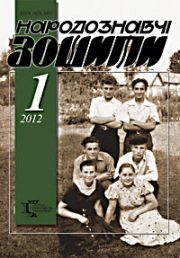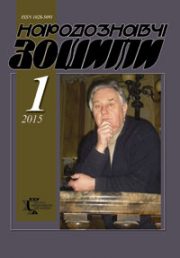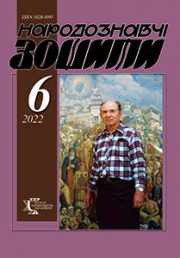The Ethnology Notebooks. 2024. № 2 (176), 407—414
UDK 739+745.53]929(477.85/.87)
DOI https://doi.org/10.15407/nz2024.02.407
THE HUTSUL REGION FLAMING HEPHASTUS ROMAN STRINADIUK
YUSYPCHUK Yurii
- ОRCID ID: https://orcid.org/0000-0001-7130-2338
- Candidate of Art Studies (P.D), Associate Professor,
- Educational-Scientific Institute of Arts;
- Vasyl Stefanyk Precarpathian National University,
- Department of Visual of Arts,
- Decorative and Applied Arts and Design Methods of Theaching,
- 33/6, Hrushevskui str., Ivano-Frankivsk, Ukraine,
- Contacts: e-mail: yurii.yusypchuk@pnu.edu.ua
Abstract. The article explores the creative work of the famous master of Hutsul land Roman Strynadiuk. His work is currently not sufficiently covered in the literary sources. The analysis of the famous creative works of the master determined the relevance and novelty of the study.
The article is aimed to describe the artistic and stylistic features of Roman Strynadiuk’s pieces of works, to analyze the compositional peculiarities of his creative works, to highlight the unknown pages of the biography of the famous master of artistic metal processing.
The object of the study is the master’s works preserved in Ukrainian museums and private collections. The subject of the study is the artistic and compositional features of metalworking pieces of work.
The methodological basis of the work is the historical and structural analysis of the principles of compositional solution of the artist’s works, the analysis of the individual ornamental motifs of his metalworking pieces of work. The professional publications by Ukrainian scholars on the work of the master of metal art Roman Strynadiuk and on the development of mosaic and metal art in the Hutsul region serve as the source base of the article.
The article studies the artistic products of non-ferrous metals in the Hutsul region which impress by the variety and richness of their range, creative imagination, decorativeness, and perfection of technical execution. The first non-ferrous metal artworks in the Carpathian region date back to the end of the 17th century.
Roman Strynadiuk was a master of artistic metalworking who managed to form his own style which inspite of being significantly different from other masters’ works always remains closely connected with the Hutsul old traditions of non-ferrous metal artistic processing.
Thus, Roman Strynadyuk’s creative heritage is rather the maintainment of the development of the art of metal processing and not its dicline. Roman Strynadiuk has significantly expanded the range of products and the list of technological processes typical for the nineteenth and twentieth centuries.
Keywords: arts and crafts, Hutsul region, metalworking, mosaic making, blacksmithing.
Received 22.03.2024
REFERENCES
- Romanovskyi, V.S. (2014). The main problems and achievements of modern research on the monuments of Trypillia archaeological culture. Visnyk Kharkivskoi derzhavnoi akademii kultury (Issue 44, pp. 4—13). Harkiv [in Ukrainian].
- Yusypchuk, Yu. (2018). Carving and metalwork in the Hutsul region in the first half of the nineteenth century. Ethnology notebooks, 5 (143), 1168—1175 [in Ukrainian].
- Solomchenko, Oleksii. (1969). Folk talents of the Carpathian region. Kyiv [in Ukrainian].
- Yusypchuk, Yu. (2016). Vasyl Devdiuk is a master of Hutsul carving and metalsmithing. Ivano-Frankivsk: Misto NV [in Ukrainian].
- Yusypchuk, Yu. (2008). The traditions of artistic wood and metal of the Hutsul region. Mystetstvoznavstvo’07 (2), 59—64 [in Ukrainian].
- Hryniuk, Mariia. (2010). The fiery miracle of Roman Strynadiuk. Ivano-Frankivsk: Misto NV [in Ukrainian].






